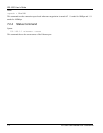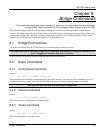
IES-1000 User’s Guide
8-8 Bridge Commands
The following figure illustrates that port 1 (the Ethernet port) is linked to ports 2 (DSL port 1) and 3 (DSL port 2).
Ports 2 (DSL port1) and 3 (DSL port 2) are also linked to each other. Or, in other words, the following figure is a
result of the following commands:
192.168.1.1 bridge> portfilter 2 1 3
192.168.1.1 bridge> portfilter 3 1 2
Figure 8-4 Example of Modified VLAN Settings
8.6 Tagged Ethernet Frames Commands (Fast Mode)
The network module’s fast mode makes use of the “tag” subset of the IEEE 802.1Q standard to identify the source
port of an Ethernet frame and speed traffic through a service gateway. In this way, the source port of a frame can be
recognized across switches.
8.6.1 PVID Command
Syntax:
192.168.1.1 bridge> pvid [<port> <vid>]
where
<port> =
port number of the network module. Port 0 is the CPU’s port, port 1 is the Ethernet
port and ports 2-9 are the bridge ports on network module modules. These are logical
ports.
<vid> =
The tag number (or IEEE 802.1Q identification) that identifies the source port of an
Ethernet frame. Allocate tag numbers for all logical ports on your network module.
This command lets you allocate IEEE 802.1Q identification numbers (tags) on a port-by-port basis.
The command 192.168.1.1 bridge> pvid displays the default port identification of all network module ports.
The IEEE 802.1Q standard uses an explicit tag in the header to specify the VLAN ID (VID) of an Ethernet frame.
In this way, the VLAN membership of a frame can be carried across switches. The following table displays the
physical port and corresponding default PVID tag on the IES-1000.


















